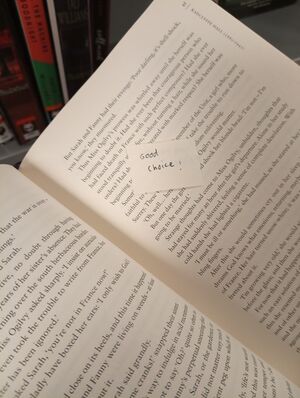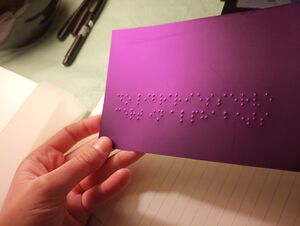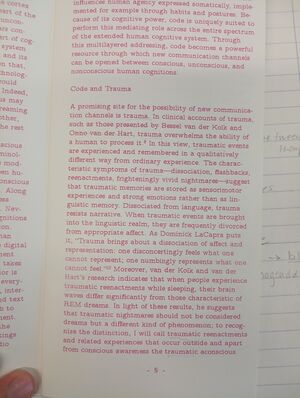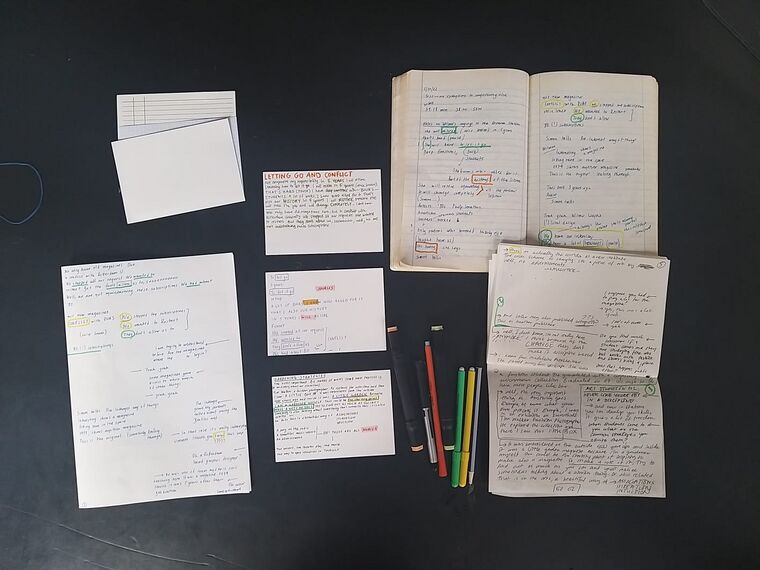How do We Library That???: Difference between revisions
No edit summary |
No edit summary |
||
| Line 161: | Line 161: | ||
https://criticalinquiry.uchicago.edu/traumas_of_code_by_n._katherine_hayles | https://criticalinquiry.uchicago.edu/traumas_of_code_by_n._katherine_hayles | ||
[[File:The trauma of coding.jpg|center|thumb|The trauma of coding, text from the bootleg library]] | [[File:The trauma of coding.jpg|center|thumb|The trauma of coding, text from the bootleg library]] | ||
=== Transcribing Wilma's sayings with Irmak- THE CARDS === | |||
Project description (log line) | |||
'''what''': 2 handwritten transcriptions of the same text. An extract of an interview with Wilma, librarian at WdK and HR for the last 36 years. The two handwritten transcriptions serve as a conversation between the two notetakers. The similarities and differences between the two texts. (At time of talking these notes). Ingedients include: pen, pencil, paper, ears, hands. The conversation can be extended to more cards. | |||
'''how''':-(At time of talking these notes [2pm]) The [5] cards serve as an interface to other texts (through hyperlinks and references) | |||
'''why''': Both Aglaia and Suzan were interested in conveying the space and atmosphere of the conversation. They want to convey the experience of the conversation (and not just the information it transmits). | |||
Steps needed: | |||
* make 5 cards | |||
* separate into scenes (there was an order to the notes, but the cards could have an order or not!) | |||
* more structure: makes it more legible | |||
* less structure: good because its a game (it flows). | |||
* maybe potential for people to add their own cards? the not-solid structure might give this possibility, even if complicated. | |||
* How can they make the people using the card understand the atmospher/have the same experience | |||
* Aglaia says other people cant ultimately have the same experience though (goal unachievable), or is it? | |||
* play with sound effects and typography, maybe work the sound effects into the text like a play | |||
* how can a reader of the card understand phrases like ("this book") | |||
* Make a shelf on the b side of the cards maybe, when you read "this" and it's underlined or footnoted, you can turn the card around and it's referencing the footnote | |||
* maybe a qr code? | |||
* reference to position in the library | |||
* aglaia took more vertical approach to the text, while suzan took more linear and tried to follow the conversation between te people speaking | |||
* aglaia made more of a note mapping | |||
[[File:Manual transcribing of Wilma's words .jpg|center|thumb|760x760px|manual transcription of Wilma's words with Irmak]] | |||
Revision as of 15:14, 2 April 2023
ή πως το ουσιαστικό μετατρέπεται σε ρήμα/σε ενέργεια? What is a Library?/ How someboby libraries? the library is a place, a storage, a sphere, politics, relations, power, authority, containt, data, archive, history? But which history? How many histories exist?
Library Tour
Making Cards the first cards
talking notes | notes talking
Boyana, Suzan and Aglaia started their tour by visiting the Central Library of Rotterdam on Friday. They went to the third floor to search for some inernational books. Wandering around at the english section Suzan picked the book Queer: LGBTQ writing from Ancient Times to yesterday edited by Grank Wynne. She started leafing through when suddenly came across a notes' discussion-a small square piece of paper:
- -Good choice!
- -I very much agree!
A small conversation between two readers. A non-time and non-site conversation. The book becomes the reference point - reinvents the time and the space of this relation-constitutes a small universe.
sensorship / lybraille-e
or lyi(brar)ing down in the margin (degrees of representation- there is a diagram at the paper of Olson "Mapping beyond Dewey's Boundaries")
see also: digitizing/printing, being kind to the reader, republishing
see also: censorship, including/excluding
All reading is a form of touching, and the act creates a connection between the reader and the text. Some texts encourage reading from certain readers (such as those typeset in braille), while some attempt to be universally accessible (such as those using OCR-A and OCR-B fonts).
Apparently the title "The Medium is the Massage" was in fact a typo after being sent to the typesetter, but McLuhan liked it so much that it was kept. Massage and also Mass Age alongside the original Message and Mess Age suggest multiple ways of approaching the text.
Reimaging together the library as a structure/institution/entity- the Hero and the CarrierBag Library
Hero Library
What is the economy of knowledge? How knowledge was produced and distributed in the hero library?
you have to pay something in order to get access, earn it. you have to be able to afford it.
it's exclusive not inclusive
cannon - 1/ power - 2/ wealth - 3/ growth
hero's library would be monumental with columns.
silent
how do you make a library start and end
limited access (physical or non-physical, stairs or paywall)What is the economy of knowledge? How is knowledge distributed and produced?
the same translates to non-phisical spaces but digital libraries too. subscription models and levels of access
special cards and special treatments and monumental large scale concrete/marble/stone buildings.. the few privileged ones get the most special knowledge the most valuable.. what is the most valuable knowledge? who are the privileged ones? how did they manage to acheive this? the top? UP/VERTICAL, surveillance and control, aesthetics of power (regarding the construction)---maybe the knowledge itself has to do with the consumption/we consume knowledge/information we do not create/produce
no non-silent rooms or group working areas
obedience
the knowledge is rather taken (acquired) from somewhere else
, many levels from bottom to the top. the higher you go the most important stuff you can access (the most valuable knowledge)
big history section on victories
censorship?
security
many mirrors inside
property/ ownership of knowledgement
Hero's library slogan:
hoc est quod vos adepto
echo chamber (Stephen)
-there may be many replicas of the same book. "the bible of the hero library" rewritten, how to read "the bible of the hero library", new edition, new cover etc.
there can only be one hero library (with notion to capitalism as Bo said)
Carrier Bag Library
What is the economy of knowledge? How knowledge was produced and distributed in the Carrier Bag library?
free access, exchangeable, everyone has the same
you could request books depending on your research
what monuments could there be?maybe no static monuments.. maybe counter monuments-always vulnerable and transformative
flexible, open, adjustable, circular, limitless (can add and add and add and transform), without borders, liquid or smooth textured, horizontal, people make their own decisions/terms of classification/organization
A bag where people add as much as take away, where the mastery of knowledge is less important than the sharing of information, mutual knowledge
Leeszaal (no checkout, relationship built on trust and knowledge not seen as private propriety) Within a society of surplus, book donation makes sense
looks like a net (network), each part is connected to each other, through knots _ nodes (some small, some bigger)
infinite?
no checkout policy
mobile and it can change place
Who has ownership over the objects?
open to risks- but easy to reconstruct due to collectivity (knowledge is fluid)
living form/changing constantly- knowledge to find solutions
bags made of reeds
what happens if a carrier bag librarian walks into a hero library? what would give them away?
^^^this sounds like the start of a joke
what are the rules in a carrier bag library? who decides the rules, are they fixed?
An archive that is not static, is only useful if it's useful to users
"May be seen as necessary elements of a whole, which itself cannot be characterised either as conflict or as harmony since its purpose is neither resolution nor stasis but continuing process" - LeGuin on carrier bags
There can be more than one carrier library in contrast to capitalism.
Carrier bag library slogan(s):
Donna Harraway (riffing on Ursula LeGuin's HBToF):
“It matters what matters we use to think other matters with; it matters what stories we tell to tell other stories with; it matters what knots knot knots, what thoughts think thoughts, what descriptions describe descriptions, what ties tie ties. It matters what stories make worlds, what worlds make stories.”
To edit the vosk-trascribed text
(the process of trauma)
I replace the original word trauma in the text with the word blue. Why blue? There is no special or deeper reason for me choosing to replace the trauma with blue. Maybe I was feeling a little blue on Monday so it has something of me also. Additionally, the written brochure text was in magenda colour and I thought blue was a nice contrast. I considered it as a nice play. This is how voxt translated my voice and my balkan/greek pronounciation into written digital text . Irestored the machine's mistakes. I replace the word trauma with blue and I gave some space after the traymatic blue
Here the vosk trenscribed text:
gold and blue a promising side of the bushmeat of new communication channels as blue niggling clinical accounts of blue such as those person by bessie of on the call and on of on the heart blue overwhelms the ability for human process it in this few blue events are experiencing remembered inequality bleed the a friend away from ordinary experience a characteristic symbols of blue is this association flashbacks reenactments frighteningly with nightmares suggests that blue members are stored does sensory motor experience and struggle motions or other than assume waste memory dissociate from language blue resist narrative when blue events are brought into the linguistic reality they are frequently the from appropriate effect as dominic look out but boots blue brings about association of effect and representation one disconcertingly fees that one cannot represent one numbingly represents what one cannot fee moreover been cold and of on their huts research indicates that the when people experience blue reenactments while sleeping their brain waves the for a significantly from those characteristic of rdm dreams in light of this result he suggests that blue nightmarish not be considered dreams but a different kind of phenomenon who recognized distinction a will call blue reenactments related experience that a cure outside and apart from conscious awareness the blue unconscious
The edited text:
a promising site of the possibility of new communication channels is blue
in clinical accounts of
blue
such as those presented by Bessel van der Kolk and Onno van der Hart
blue
overwhelms the ability for a human to process it in this view
blue
events are experienced and remembered in an qualitatively different way from ordinary experience the characteristic symptoms of
blue
is dissosiation flashbacks reenactments frighteningly vivid nightmares suggests that
blue
memories are stored as sensorimotor experiences and strong emotions rather than as linguistic memory dissociated from language
blue
resists narrative when
blue
events are brought into the linguistic realm they are frequently divorced from appropriate affect as Dominick LaCapra puts it
blue
brings about dissociation of affect and representation one disconcertingly feels what one cannot represent one numbingly represents what one cannot feel moreover van der Kolk and van der Hart's research indicates that when people experience
blue
reenactments while sleeping their brain waves differ significantly from those characteristic of REM dreams in light of these results he suggests that
blue
nightmares should not be considered dreams but a different kind of phenomenon to recognize the distinction I will call
blue
reenactments and related experiences that occur outside and apart from conscious awareness the blue
aconscious
https://criticalinquiry.uchicago.edu/traumas_of_code_by_n._katherine_hayles
Transcribing Wilma's sayings with Irmak- THE CARDS
Project description (log line)
what: 2 handwritten transcriptions of the same text. An extract of an interview with Wilma, librarian at WdK and HR for the last 36 years. The two handwritten transcriptions serve as a conversation between the two notetakers. The similarities and differences between the two texts. (At time of talking these notes). Ingedients include: pen, pencil, paper, ears, hands. The conversation can be extended to more cards.
how:-(At time of talking these notes [2pm]) The [5] cards serve as an interface to other texts (through hyperlinks and references)
why: Both Aglaia and Suzan were interested in conveying the space and atmosphere of the conversation. They want to convey the experience of the conversation (and not just the information it transmits).
Steps needed:
- make 5 cards
- separate into scenes (there was an order to the notes, but the cards could have an order or not!)
- more structure: makes it more legible
- less structure: good because its a game (it flows).
- maybe potential for people to add their own cards? the not-solid structure might give this possibility, even if complicated.
- How can they make the people using the card understand the atmospher/have the same experience
- Aglaia says other people cant ultimately have the same experience though (goal unachievable), or is it?
- play with sound effects and typography, maybe work the sound effects into the text like a play
- how can a reader of the card understand phrases like ("this book")
- Make a shelf on the b side of the cards maybe, when you read "this" and it's underlined or footnoted, you can turn the card around and it's referencing the footnote
- maybe a qr code?
- reference to position in the library
- aglaia took more vertical approach to the text, while suzan took more linear and tried to follow the conversation between te people speaking
- aglaia made more of a note mapping




